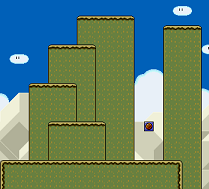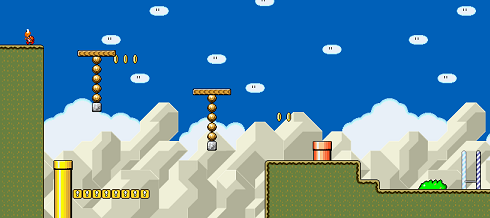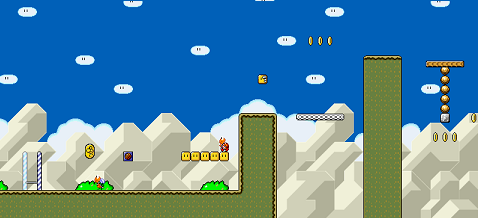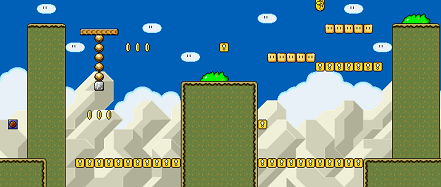vgthought.com
Frames and Themes in Super Mario World
Posted: 2014-01-22 21:42:05
Last edited: 2014-02-27 19:33:30
Last edited: 2014-02-27 19:33:30
This was originally posted on June 7, 2010.
This essay was kind of an epiphany for me. To fully engage a video game, you need to value each and every moment as significant. Good or bad, each moment contributes to the overall effect a game has on the player.
This essay is still flawed in that regard, because it glosses over collectibles and enemies. And, as with all of my old stuff, it could use some reorganizing and cleaning up. Even then, I'm told that this essay is my most successful work.
This essay was kind of an epiphany for me. To fully engage a video game, you need to value each and every moment as significant. Good or bad, each moment contributes to the overall effect a game has on the player.
This essay is still flawed in that regard, because it glosses over collectibles and enemies. And, as with all of my old stuff, it could use some reorganizing and cleaning up. Even then, I'm told that this essay is my most successful work.
Games discussed:
Super Mario World
Super Mario World design contains one of the most basic elements of art: framing. Seeing stages in frames helps to recognize the stage’s themes, ideas, and how the stage progresses. With this in mind, Yoshi’s Island 3 is a good starting point, since it demonstrates these ideas simply.

Yoshi’s Island 3 opens with this series of platforms. Mario enters the stage on the bottom platform. Before making any horizontal progress in the stage, the player must ascend to the top. This is hardly required; the programmers could have placed Mario’s entrance at the top if they wanted. For example, the entrance to Forest Secret Area is at a high altitude. Here, however, the programmers chose to have the player work his or her way upwards at the very start.

Just before the midpoint, Mario descends...

...then ascends again.

The stage ends with another descent.
This demonstrates two basic concepts of Super Mario World stage design.
First, stages are framed; the beginning of a stage feels like a beginning, and the end of a stage feels like an end. In the case of Yoshi’s Island 3, the player is venturing over a mountain. When the stage begins, the player goes up one side, and when the stage ends, the player goes down on the other side.
Second, midpoints mark a shift in a stage. Midpoints in Super Mario World join two stages that are related by theme. That is to say, the portion of a stage before the checkpoint and the portion of a stage after the checkpoint could be taken as separate stages, with independent pacing, difficulty curves, and framing.
In Yoshi's Island 3, the midpoint provides a sense of security only offered by the beginning and ending of the stage. The start of the stage contains a segment of land almost long enough to fill the entire screen width. This lends a sense of security since the player knows there is no risk of death; there is plenty of ground and little opportunity to fall in a bottomless pit. When Mario moves forward in the stage, though, the platforms become much thinner and there is no ground visible below. If Mario falls at this point, there is a chance he might fall into a bottomless pit. However, at the midpoint and at the conclusion of the stage, platforms are wide and low on the screen. The stage offers security at its beginning, its end, and at the midpoint.
The midpoint is much more than a place for the player to continue the stage if he or she should die; the midpoint also marks the end of first segment and the beginning of the second. In other words, the midpoint contains the end of the stage's first frame and the beginning of the stage's second frame. Yoshi’s Island 3 reflects this with elevation.
What’s this frame of elevation change wrapped around, then?

Yoshi’s Island 3 focuses on the juxtaposition of player dependent platforms versus player independent platforms. That is, player dependent platforms behave based on what the player does. Player independent platforms always do the same thing, regardless of what the player does.
Throughout the stage, tall platforms are matched by yellow ! blocks below. The tall platforms are in the stage regardless (player independent), while the yellow ! blocks appear only after the player has cleared the Yellow Switch Palace (player dependent).
More striking, however, are the moving platforms. The screen shot above shows the first two bottomless pits in the stage, assuming the player has not activated yellow ! blocks. The first is bridged by a player dependent rotating platform. This platform only rotates while Mario is standing on it; its movement is dictated by the weight of Mario’s body.
Above the second bottomless pit are two player independent expanding platforms. These platforms expand and contract on their own and are not influenced by the player.
This continues; the third bottomless pit has a player dependent rotating platform, and above the fourth bottomless pit are two player independent platforms. These two do not expand and contract, but rather, move horizontally and vertically on their own, again with no influence from the player.
Over the fifth bottomless pit are two player dependent rotating platforms, and after this, Mario reaches the midpoint.
There’s three things to note about this: framing, rhythm, and stage progression. It demonstrates framing by matching the first bottomless pit; within the first half of Yoshi’s Island 3, both the first and last bottomless pits contain player dependent rotating platforms.
Rhythm comes into play by the back-and-forth of player dependent and independent platforms. It starts with a dependent platform, then uses an independent one, then goes back to a dependent one, so on and so forth. This draws out the difference between the two types of platforms. On the other hand, because there is only one variety of player dependent platform used and two different varieties of player independent platforms, the player dependent platform gets the most focus; it appears the most.
Finally, it shows stage progression by increasing the difficulty; before, only one lone player dependent rotating platform had ever been placed over a bottomless pit. At the end, however, the player must traverse two of them to cross the bottomless pit. Super Mario World stages often close with one part that is particularly difficult compared to the rest of the stage.

The second half of Yoshi’s Island 3 (most of which is shown in the screenshot above) varies upon the theme set in the first half (the juxtaposition of player dependent and independent platforms suspended high in the stage).
The bottomless pits are wider, and rather than switch between platform types often, this part of the stage features large groups of similar platforms. The middle of this section contains a series of expanding and contracting player independent platforms, followed eventually by a section of player dependent rotating platforms.
As a result of the longer bottomless pits, the second half of Yoshi’s Island 3 intensifies the ideas of the first half. The player must travel between moving platforms much more often and has much less safe ground. This intensity is matched by the lack of rhythm; instead of switching back and forth, this segment lingers on long strings of similar platforms.
The exception to this focus is in horizontally- and vertically-moving player independent platforms. The second half opens with a vertical one right before the first rotating platform. Then, a horizontal platform appears right before the final string of three rotating platforms. While this segment lingers on other platform varieties for long periods of time, the horizontal and vertical platforms just pop in one at a time.
And don't forget that lone rotating platform that appears before the long string of expanding platforms, throwing in a bit of user dependence right before a gauntlet of user independence.
Framing often highlights the theme and variation found in Super Mario World levels. Once you recognize how a stage is framed, you can begin to see a stage’s themes and ideas contained within the frame. Within a single segment of a stage, ideas are developed and complicated, increasing the difficulty as the segment goes on. If the stage has a second half, the second half will use the basic theme and some ideas of the first half along with a twist for variation.
A word on feet
In meter, a foot is one basic unit. The first half of Yoshi's Island 3 establishes a rhythm by which we can define feet. Player dependent platforms appear one at a time, so one of those may be considered a foot all on its own. However, player independent platforms always appear in pairs, so for them, one foot means two platforms. As I discussed earlier, the final pit of the first half is a grand finale, so it puts two feet of player dependent platforms right next to each other without a break.
Let's take this idea to the second half of the stage. Over the second bottomless pit (the first bottomless pit in that last screen cap), there's one rotating platform followed by six player independent expanding platforms. So, that's one player dependent foot followed by three player independent feet.
The third bottomless pit has one player independent horizontal platform and one rotating platform. This introduces a sense of dynamism--the player independent foot is cut short, since there's only one platform for it.
comments powered by Disqus
All original content on VG Thought was written by Greg Livingston AKA Golem.